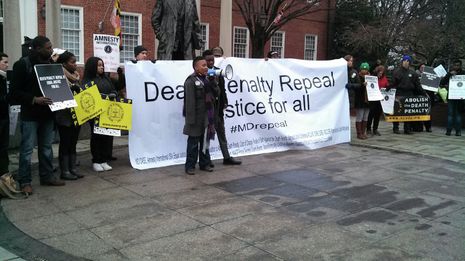We can’t let ourselves fall into the capital punishment trap
Against a backdrop of federal executions in America and signs of a worrying shift towards a favourable view of capital punishment in Britain, Joe Giles argues that a return to the death penalty would be detrimental to the fabric of our society.

Content Note: This article includes graphic depictions of capital punishment
At around 8am on execution day, Albert Pierrepoint and his assistants entered the designated cell, bound their prisoner’s arms with a leather strap, and proceeded to the gallows. Having carefully calculated the length of the drop with sandbags the previous evening, the executioner offered his charge a final swig of brandy and an opportunity to express any last words, then placed a white hood over their head and escorted them to a spot marked ‘T’ above a trapdoor, where a noose was placed around their neck. Pierrepoint pulled a large lever, opening the trapdoor and severing the spinal cord.
The body was usually left suspended for between twenty minutes and one hour until death was confirmed, then buried in an unmarked grave within the prison walls.
This haunting, macabre process is one that Britain’s most prolific 20th-century hangman followed over 500 times between 1931 and 1956. We tend today to view capital punishment through a distant, American lens: docuseries like Life and Death Row have exposed the inner workings of the USA’s controversial brand of justice. Now, at the head of a grim roll-call of headlines, including those concerning Lisa Montgomery, Donald Trump has become the first lame-duck president to oversee an execution since the 19th century, and is set to federally execute more prisoners in a year than any previous US president.
Yet, with worrying signs of a shift in UK foreign policy and an incumbent Home Secretary who has previously expressed support for the death penalty, it is worth examining Britain’s own relationship with capital punishment - along with the implications for its reinstatement.
“All the men and women whom I have faced at that final moment convince me that in what I have done I have not prevented a single murder.”
From a purely practical standpoint, no argument for capital punishment withstands serious scrutiny. The most often-cited defence, one which Priti Patel put forward when discussing the issue on Question Time in 2011, is that harsh penalties serve as a deterrent to would-be criminals. Apart from the obvious consideration that murderers and terrorists are unlikely to rationalise their crimes before committing them, numerous studies have found this claim to be entirely false: murder rates in US states which have abolished the death penalty are no higher than those which persist with it. Consider the testimony of the aforementioned hangman Pierrepoint, who wrote in his 1974 autobiography: ‘It did not deter them then, and it had not deterred them when they committed what they were convicted for. All the men and women whom I have faced at that final moment convince me that in what I have done I have not prevented a single murder.’
Pierrepoint resigned nine years before the 1965 Murder Act scrapped the death penalty, and became an advocate for its abolition elsewhere. His autobiography implies that presiding over some of the most contentious executions in British history took a heavy emotional toll. Among his condemned were Timothy Evans, a man with the mental age of an 11-year-old, executed in 1950 and later proved innocent of murdering his family. Then there was Mahmood Hussein Mattan, 1952: posthumously cleared when it was found that a different Somali had committed the murder of which he was convicted.
1955 saw perhaps the most notorious execution of all. Ruth Ellis, the last woman to be hanged in Britain, was condemned for shooting her abusive boyfriend. Images of Ellis show her bruised and desperate, yet the Home Office pressed mercilessly ahead with her sentence.
These executions were either carried out entirely wrongfully, or with sufficient mitigating circumstances that hanging should never have been considered. What they show is the potential for fallibility and prejudice within our justice system; while trials are undoubtedly more scrupulous than they were 60 years ago, the USA continues to perform wrongful executions, with death sentences most likely to be given to members of ethnic minority groups and those with severe mental disorders.
Such tragedies furthered the cause for abolition, advocated by Home Secretary Roy Jenkins and backbench Labour MP Sydney Silverman. Jenkins’ 1960s liberal reforms remain extraordinary today. They passed in spite of widespread support for the status quo, a rare example of political courage in spite of unfavourable public opinion. They established a new political consensus: no subsequent administration has made any serious attempt to overturn Jenkins’ legislation.
“Sajid Javid’s failure ... represents an alarming and unprecedented departure from our established consensus.”
Britain can be genuinely proud of its record on this issue since 1965. Successive governments have withstood public pressure to reinstate death sentences, and have lobbied for abolition around the world. In 2011, the UK stopped exporting a drug used by the USA in lethal injections, and it is government policy to refuse to extradite prisoners unless assurances are given that capital punishment will not be inflicted. Sajid Javid’s failure last year to seek this guarantee for two ISIS terror suspects tried in America represents an alarming and unprecedented departure from our established consensus.
Yet public support for capital punishment in the UK continues to hover around the 50% mark for the most serious crimes, and tends to spike when a particularly heinous incident takes root in the nation’s consciousness. Ian Brady and Myra Hindley, tried a year after abolition, represent perhaps the most notorious examples of this. But similar calls for the reinstatement of the death penalty followed the trials of the Guildford Four and Birmingham Six, accused IRA bombers in the 1970s who were later cleared of all charges, and whom, if wrongfully executed, would have become dangerous martyrs in an escalating conflict.
This is why it is flawed to view capital punishment on a case-by-case basis: it is not about humanising or excusing the crimes of a deranged serial killer; instead, we must ask ourselves what kind of society pursues a retributive, unethical penalty which serves no preventative purpose and commits its own irreparable mistakes. As Desmond Tutu said on the subject, ‘to take a life when a life has been lost is revenge, not justice’. We are fortunate as a nation to have realised the truth of this over 50 years ago - a truth that our current government would do very well to remember.
 News / SU stops offering student discounts8 January 2026
News / SU stops offering student discounts8 January 2026 News / Uni-linked firms rank among Cambridgeshire’s largest7 January 2026
News / Uni-linked firms rank among Cambridgeshire’s largest7 January 2026 Comment / Plastic pubs: the problem with Cambridge alehouses 5 January 2026
Comment / Plastic pubs: the problem with Cambridge alehouses 5 January 2026 News / New movement ‘Cambridge is Chopped’ launched to fight against hate crime7 January 2026
News / New movement ‘Cambridge is Chopped’ launched to fight against hate crime7 January 2026 Comment / What happened to men at Cambridge?31 December 2025
Comment / What happened to men at Cambridge?31 December 2025









